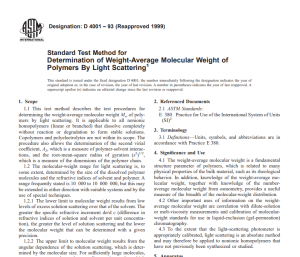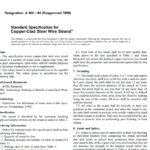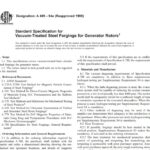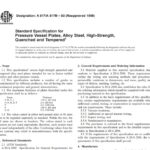Standard Test Method for
Determination of Weight-Average Molecular Weight of
Polymers By Light Scattering1
This standard is issued under the fixed designation D 4001; the number immediately following the designation indicates the year of
original adoption or, in the case of revision, the year of the last revision. A number in parentheses indicates the year of last reapproval. A
superscript epsilon (e) indicates an editorial change since the last revision or reapproval.
1. Scope
1.1 This test method describes the test procedures for
determining the weight-average molecular weight Mw of polymers by light scattering. It is applicable to all nonionic
homopolymers (linear or branched) that dissolve completely
without reaction or degradation to form stable solutions.
Copolymers and polyelectrolytes are not within their scope. The
procedure also allows the determination of the second virial
coefficient, A2, which is a measure of polymer-solvent interactions, and the root-mean-square radius of gyration (s
2
)
1/2,
which is a measure of the dimensions of the polymer chain.
1.2 The molecular-weight range for light scattering is, to
some extent, determined by the size of the dissolved polymer
molecules and the refractive indices of solvent and polymer. A
range frequently stated is 10 000 to 10 000 000, but this may
be extended in either direction with suitable systems and by the
use of special techniques.
1.2.1 The lower limit to molecular weight results from low
levels of excess solution scattering over that of the solvent. The
greater the specific refractive increment dn/d c (difference in
refractive indices of solution and solvent per unit concentration), the greater the level of solution scattering and the lower
the molecular weight that can be determined with a given
precision.
1.2.2 The upper limit to molecular weight results from the
angular dependence of the solution scattering, which is determined by the molecular size. For sufficiently large molecules,
measurements must be made at small scattering angles, which
are ultimately outside the range of the photometer used.
1.3 The values stated in SI units are to be regarded as the
standard.
1.4 This standard does not purport to address all of the
safety concerns, if any, associated with its use. It is the
responsibility of the user of this standard to establish appropriate safety and health practices and determine the applicability of regulatory limitations prior to use.
NOTE 1—There are no similar or equivalent ISO standards.

Click below to download Astm D 4001 – 93 (Reapproved 1999) pdf free
Click here to download Astm D 4000 – 04 Pdf Free Download






